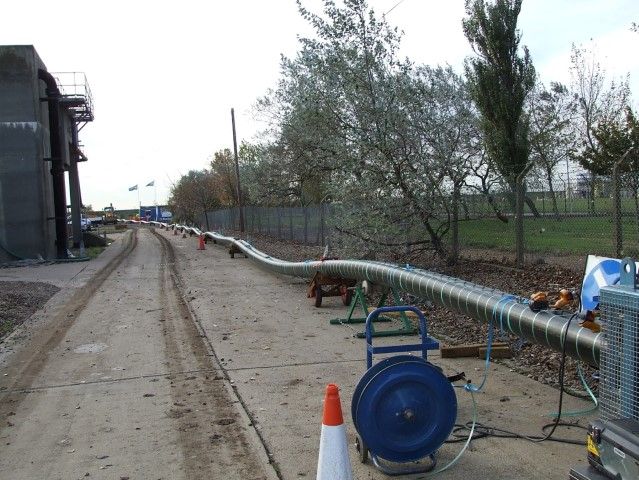Pipe Assembly and Handling
PE100 pipe can be supplied in coils up to DN180. For all diameters that are too large to be supplied in coils the pipe will be supplied to site in straight lengths. These will be butt fusion welded at site into a string or, if there is not sufficient room, two or more strings.
Where the liner pipe has to be moved after being strapped, it is better to move it on carriages that roll along with the pipe, as this reduces the risk of straps being damaged as they pass over rollers. Another advantage of carriages is that they can be designed with a long saddle, and so will not indent the liner pipe to the same extent as rollers.
Larger diameters with high SDRs (i.e. thin wall) often exhibit considerable ovality, so the ends of coiled pipe need to be aligned and rerounded by the use of suitable equipment such as re-rounding clamps when butt fusion jointing. Butt fusion machine clamps should act as re-rounding clamps The external beads must be removed carefully and completely, and all external joint beads should be removed and inspected followed by the application of a “bend back” test to check the joint integrity.
All pipe lengths must be carefully inspected for damage before being welded onto the string. PE100 is a robust and resilient material but care should be taken not to cause excessive scuffing or gouging of the surface. Surface damage may occur during handling, storage and installation, but providing the depth of any score is no greater than 10% of the wall thickness, then the service performance of the pipe or fitting will not be affected.
The liner pipe string must be placed on rollers during movements and attention should be given to roller design to ensure that there are no sharp edges or protrusions to damage the liner pipe if it accidentally comes off the roller whilst being moved. It is important that the liner pipe be thoroughly cleaned and inspected for dirt or damage before arriving at the fusion machine, particular attention being given to the underside, and this is best achieved by locating the pipe cleaning and final inspection stations at the approach to the fusion machine.
If a fold & form process is used and the liner pipe is pushed through the folding machine, a winch is used during the insertion to overcome the frictional forces within the host pipe, and a pulling head must be attached to the liner pipe so that it can be connected to the winch wire. This is attached after the nose of the liner pipe has been folded. As it only has to transmit a relatively low force, it can be a simple device. Also, it is necessary to incorporate a spinner so that the liner pipe is not rotated during insertion.

Image courtesy: Exova Utilities

Image courtesy: Exova Utilities

Image courtesy: Exova Utilities
In order to pull the liner pipe through the host pipe, a pulling head must be attached to the liner pipe so that it can be connected to the winch wire or rod system, whichever is being used. If a concentric close-fit lining method is being used this pulling head must be small enough to pass through the rollers or die, yet must be the same diameter as the liner pipe, and so has to be tapered.
The pictures above and below show such a head being applied, the wrapping simply being to reduce the risk of snagging and to avoid scraping the inside of the host.

Image courtesy: Exova Utilities
This type of pulling head, usually called a ‘nose cone’, is made by cutting ‘V’ shaped pieces out of the end of the liner pipe, and pulling the ‘fingers’ that remain down onto a steel hub. However, as the fingers get narrower the stress will increase, and as the width at the bolting plates is about halved, such a pulling head could fail during insertion. This can be overcome by first butt fusing a length of pipe with a suitably lower SDR onto the end of the liner pipe, and the fingers can be cut into this pipe which must be removed after insertion and must not be part of the permanent installed pipe. Alternatively, this type of pulling head is fabricated off site, and simply butt fused onto the end of the liner pipe.

Image courtesy: Exova Utilities
This type of pulling head is also used for HDD applications, where the insertion tensions can be very high, and the bore is full of mud which should not get inside the PE pipe to contaminate it, and particular attention must be given to sealing the drilling rod attachment.

Image courtesy: Exova Utilities
USEFUL LINKS
Slip-lining is perhaps the oldest of all trenchless techniques . It involves the insertion of a new PE100 or PE100-RC liner pipe of standard diameter and SDR into an existing pipe. Under the right conditions, slip lining is also the simplest trenchless technique. A new pipe with an outside dimension smaller than the inside dimension of the host pipe is either pulled or pushed into the host pipe. The ideal host pipes for slip lining are straight with no deformities, no or modest bends, no severe protrusions into the pipe, and only modest offset joints.

